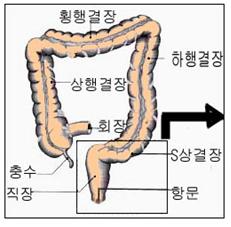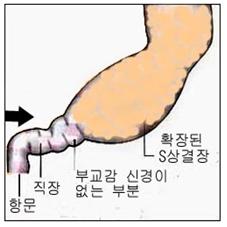선천성 거대결장, Congenital megacolon

그림 141. 정상 대장.
Copyright ⓒ 2011 John Sangwon Lee, MD., FAAP

그림 142. 선천성 거대결장.
Copyright ⓒ 2011 John Sangwon Lee, MD., FAAP
| 선천성 거대결장의 원인 |
- 항문과 S상 결장관 사이에 있는 대장 부분을 직장(관)이라 하고 그 직장관의 최상부는 S상 결장관으로 연결되고 직장관의 최하부는 항문으로 연결된다.(그림 141참조)
- S상 결장관, 직장관, 대장관(상행결장, 횡행결장, 하행결장)의 장벽에 부교감신경과 교감신경이 정상적으로 분포되어 있다.
- 교감신경과 부교감신경은 직장관, S상 결장관, 하행결장, 횡행결장, 상행결장 등 위장 연동을 조절하는 기능을 한다.
- 먹은 소대장관 속 소화된 음식물은 소장관 속, 대장관 속에서 연동으로 S상 결장관 직장관 속을 거쳐 항문 속 쪽으로 내려가는 것이 정상이다.
- 항문, 직장관 장벽 또는 S상 결장관 장벽의 일부분이나 전체에 있는 부교감신경절이 선천적으로 없을 수 있다.
- 부교감신경절이 선천적으로 없는 S상 결장관의 벽이나 직장관 벽에 연동작용이 정상적으로 생기지 않게 된다.
- 이 때 S상 결장관 속이나 직장관 속의 일부분이 부분적으로 막히거나 완전히 막힐 수 있다.
- 먹은 음식물의 대부분은 위장 소장관 속 장벽 점막층을 통과 소화된 영양분이 핏속으로 흡수되고 소화되지 않은 잔여물은 대변으로 나온다.
- 그 잔여물이 부교감신경절이 정상적으로 분포되어 있는 직장관 부분이나 S상 결장관의 부분까지 정상 연동 작용으로 내려올 수 있으나 부교감신경절이 정상적으로 분포되어 있지 않은 S상 결장관이나 직장관의 부분 이하 부분 속으로 더 이상 내려갈 수 없다.
- 그에 따라 변비증이 심하게 또는 경하게 생길 수 있다. 때로는 S장 결장관이나 직장관 장폐쇄증도 생길 수 있다.
- 이런 병을 선천성 거대결장, 또는 히르시스프룽병(Hirschsprung’s disease)이라고 한다.
| 선천성 거대결장의 증상 징후 |
- 부교감신경절이 선천적으로 없는 S상 결장관이나 직장관 부분의 길이, 부교감신경절이 선천적으로 없는 S상 결장관이나 직장관의 부분, 환아의 나이에 따라 증상 징후가 다르다.
- 먹은 음식물의 일부는 위장관(소화관) 속에서 소화된 후 위장 벽 점막층을 통해 피 속으로 흡수되고 소화되지 않은 잔여물은 대변으로 나오는 것이 정상이다.
- 이 병이 있을 때는 먹은 음식물이 소화되고 피 속으로 흡수되고 남은 잔여물이 부교감신경 절이 없는 S상 결장관 속이나 직장관 속까지 연동 작용으로 도착한 후 더 이상 항문 속 쪽으로 내려갈 수가 없다.
- 이 때 부교감신경 절이 없는 S상 결장관 속이나 직장관 속의 부분의 바로 위에 있는 S상 결장관 부분 속이나 직장관 속에 연동작용으로 내려온 잔여물-대변이 가득 차있고 그 부위의 S상 결장관 속이나 직장관 속이 비정상적으로 확장될 수 있다.
- 부교감신경 절이 없는 S상 결장관 속이나 직장관 속의 바로 아래에 있는 S상 결장관 속이나 직장관 속에는 대변이 소량 차 있거나 아주 없을 수 있다.
- 부교감신경 절이 없는 S상 결장관 속이나 직장관의 속의 바로 아래에 있는 S상 결장관의 나머지 부분이나 직장관 속의 크기는 정상 이하로 작아진다(그림 142 참조).
- 이 병이 있으면 대변을 전혀 보지 못하거나 아주 조금 보든지 또는 심한 변비증에 걸리게 된다.
- 이 병이 있는 어떤 신생아는 태변을 생후 2~3일 이후 조금 볼 수 있고, 그 후 1 주 동안 1회 정도 대변을 보기도 한다.
- 대변을 볼 때 힘을 주고 울기도 하고 방귀를 많이 낀다.
- 체중이 잘 늘지 않고 아래 배에서 대변 덩어리가 만져질 수 있고 심한 변비증이 있을 수 있다.
- 선천성 소화관 기형은 흔하지는 않지만 신생아나 영유아에게 변비증이 심할 때는 적어도 한 번 정도 이 병이 있나 의심해 볼 수 있다.
| 선천성 거대결장의 진단 |
- 병력·증상 징후·진찰소견 등을 종합해 이 병이 의심되면 S상 결장관·직장관·항문 바륨액 X-선 사진 검사, 직장관과 S상 결장관 내시경검사, S상 결장관 장벽이나 직장관 장벽 부교감신경절 생체 조직검사 등으로 진단할 수 있다.
| 선천성 거대결장의 치료 |
- 부교감신경 절이 없는 결장관이나 직장관의 부분을 절제하고 정상 부분을 서로 연결하는 수술치료를 한다.
Congenital megacolon 선천성 거대결장

Figure 141. Normal large intestine (megacolon). Copyright ⓒ 2011 John Sangwon Lee, MD., FAAP

Figure 142. Congenital large colon(megacolon). Copyright ⓒ 2011 John Sangwon Lee, MD., FAAP
Causes of congenital megacolon
- The part of the large intestine between the anus and the sigmoid duct is called the rectum, and the uppermost part of the rectal canal is connected to the sigmoid duct, and the lowermost part of the rectal canal is connected to the anus (see Fig. 141).
- Parasympathetic nerves and sympathetic nerves are normally distributed in the barrier of the sigmoid colon, rectal duct, and colon (ascending colon, transverse colon + descending colon).
- The sympathetic and parasympathetic nerves control gastrointestinal peristalsis such as the rectum, sigmoid colon, descending colon, transverse colon, and ascending colon.
- It is normal for the food digested in the small intestine that is eaten to go down into the anus through the sigmoid colon and the rectal canal through peristalsis in the small intestine and the colon.
- Parasympathetic ganglions may not be presented in all of the anus, rectum, or sigmoid colon.
- The peristalsis does not normally occur on the wall of the sigmoid duct or the rectal duct wall, where the parasympathetic ganglion is congenital missed.
- In this case, the sigmoid colon or part of the rectal canal may be partially or completely blocked.
- Most of the food eaten passes through the mucous membrane of the intestine in the gastrointestinal tract, and digested nutrients are absorbed into the blood, and the undigested residue comes out in the stool.
- The residue may come down to the part of the rectal duct where the parasympathetic ganglia are normally distributed or the part of the sigmoid duct with normal peristalsis.
- If the sigmoid duct or the part of the rectal duct where the parasympathetic ganglia are not normally distributed and then sigmoid colon or rectum obstruction can occur, this can lead to severe or mild constipation or no bowel movement at all. This disease is called congenital megacolon, or Hirschsprung’s disease.
Symptoms of congenital megacolon
- Symptoms and signs differ depending on the length of the sigmoid ganglion or rectal duct part without a parasympathetic ganglion, the sigmoid duct or rectal duct part without a parasympathetic ganglion congenital, and the age of the patient.
- It is normal for some of the food eaten to be digested in the gastrointestinal tract (digestive tract) and then absorbed into the blood through the mucous membrane of the gastrointestinal wall, and the undigested residues come out in the stool.
- With this disease, the food eaten is digested and absorbed into the blood, and the remaining residues reach into the sigmoid colon or rectal duct without parasympathetic ganglia through peristalsis, and then can no longer descend into the anus.
- At this time, in the sigmoid duct without a parasympathetic ganglion that is directly above the rectum, residues descending by the normal peristalsis to reach in the normal part of the intestine above the sigmoid without parasympathetic nerves.
- There may be little or no stool in the sigmoid tract without a parasympathetic ganglion or rectal duct directly below the sigmoid duct.
- The size of the sigmoid duct without parasympathetic ganglia or in the rectal duct is smaller than normal (see Figure 142). With this disease, your newborn can have no or very little stool, or your baby can get severe constipation.
- Some newborns with this disease may have a slight meconium 2 to 3 days after birth, and then stool once a week.
- When your newborn does stool, your newborn gives strength, your newborn cry, and your newborn fart a lot. your newborn may not gain weight well, you may feel a lump of stool in your lower stomach, and your newborn may have severe constipation.
- Congenital gastrointestinal malformations are not common, but when constipation is severe in newborns or infants, it can be suspected at least once.
Diagnosis of congenital megacolon
- If the disease is suspected by combining the medical history, symptoms, and examination findings, X-ray examination of the colon, rectal duct, and anus. barium enema, rectum and sigmoid tract.
- It can be diagnosed endoscope for rectum, sigmoid intestine and by the biopsy examination of tissue of the wall of the rectum and the sigmoid and other for the parasympathetic ganglion
Treatment of congenital megacolon
Surgical treatment is performed by resecting the part of the colon or rectal tube that does not have a parasympathetic ganglion and connecting the normal parts to each other.
출처 및 참조 문헌
- NelsonTextbook of Pediatrics 22ND Ed
- The Harriet Lane Handbook 22ND Ed
- Growth and development of the children
- Red Book 32nd Ed 2021-2024
- Neonatal Resuscitation, American Academy Pediatrics
- www.drleepediatrics.com 제1권 소아청소년 응급 의료
- www.drleepediatrics.com 제2권 소아청소년 예방
- www.drleepediatrics.com 제3권 소아청소년 성장 발육 육아
- www.drleepediatrics.com 제4권 모유,모유수유, 이유
- www.drleepediatrics.com 제5권 인공영양, 우유, 이유식, 비타민, 미네랄, 단백질, 탄수화물, 지방
- www.drleepediatrics.com 제6권 신생아 성장 발육 육아 질병
- www.drleepediatrics.com제7권 소아청소년 감염병
- www.drleepediatrics.com제8권 소아청소년 호흡기 질환
- www.drleepediatrics.com제9권 소아청소년 소화기 질환
- www.drleepediatrics.com제10권. 소아청소년 신장 비뇨 생식기 질환
- www.drleepediatrics.com제11권. 소아청소년 심장 혈관계 질환
- www.drleepediatrics.com제12권. 소아청소년 신경 정신 질환, 행동 수면 문제
- www.drleepediatrics.com제13권. 소아청소년 혈액, 림프, 종양 질환
- www.drleepediatrics.com제14권. 소아청소년 내분비, 유전, 염색체, 대사, 희귀병
- www.drleepediatrics.com제15권. 소아청소년 알레르기, 자가 면역질환
- www.drleepediatrics.com제16권. 소아청소년 정형외과 질환
- www.drleepediatrics.com제17권. 소아청소년 피부 질환
- www.drleepediatrics.com제18권. 소아청소년 이비인후(귀 코 인두 후두) 질환
- www.drleepediatrics.com제19권. 소아청소년 안과 (눈)질환
- www.drleepediatrics.com 제20권 소아청소년 이 (치아)질환
- www.drleepediatrics.com 제21권 소아청소년 가정 학교 간호
- www.drleepediatrics.com 제22권 아들 딸 이렇게 사랑해 키우세요
- www.drleepediatrics.com 제23권 사춘기 아이들의 성장 발육 질병
- www.drleepediatrics.com 제24권 소아청소년 성교육
- www.drleepediatrics.com 제25권 임신, 분만, 출산, 신생아 돌보기
- Red book 29th-31st edition 2021
- Nelson Text Book of Pediatrics 19th- 21st Edition
- The Johns Hopkins Hospital, The Harriet Lane Handbook, 22nd edition
- 응급환자관리 정담미디어
- Pediatric Nutritional Handbook American Academy of Pediatrics
- 소아가정간호백과–부모도 반의사가 되어야 한다, 이상원 저
- The pregnancy Bible. By Joan stone, MD. Keith Eddleman, MD
- Neonatology Jeffrey J. Pomerance, C. Joan Richardson
- Preparation for Birth. Beverly Savage and Dianna Smith
- 임신에서 신생아 돌보기까지. 이상원
- Breastfeeding. by Ruth Lawrence and Robert Lawrence
- Sources and references on Growth, Development, Cares, and Diseases of Newborn Infants
- Emergency Medical Service for Children, By Ross Lab. May 1989. p.10
- Emergency care, Harvey Grant and Robert Murray
- Emergency Care Transportation of Sick and Injured American Academy of Orthopaedic Surgeons
- Emergency Pediatrics A Guide to Ambulatory Care, Roger M. Barkin, Peter Rosen
- Quick Reference To Pediatric Emergencies, Delmer J. Pascoe, M.D., Moses Grossman, M.D. with 26 contributors
- Neonatal resuscitation Ameican academy of pediatrics
- Pediatric Nutritional Handbook American Academy of Pediatrics
- Pediatric Resuscitation Pediatric Clinics of North America, Stephen M. Schexnayder, M.D.
-
Pediatric Critical Care, Pediatric Clinics of North America, James P. Orlowski, M.D.
-
Preparation for Birth. Beverly Savage and Dianna Smith
-
Infectious disease of children, Saul Krugman, Samuel L Katz, Ann A.
- 제4권 모유, 모유수유, 이유 참조문헌 및 출처
- 제5권 인공영양, 우유, 이유, 비타민, 단백질, 지방 탄수 화물 참조문헌 및 출처
- 제6권 신생아 성장발육 양호 질병 참조문헌 및 출처
- 소아과학 대한교과서
|
Copyright ⓒ 2015 John Sangwon Lee, MD., FAAP 미국 소아과 전문의, 한국 소아청소년과 전문의 이상원 저 “부모도 반의사가 되어야 한다”-내용은 여러분들의 의사로부터 얻은 정보와 진료를 대신할 수 없습니다. The information contained in this publication should not be used as a substitute for the medical care and advice of your doctor. There may be variations in treatment that your doctor may recommend based on individual facts and circumstances. “Parental education is the best medicine.” |